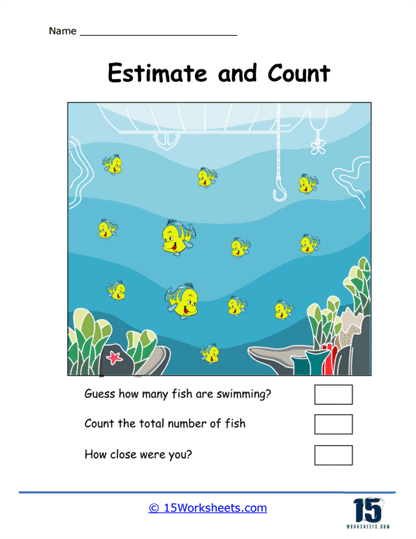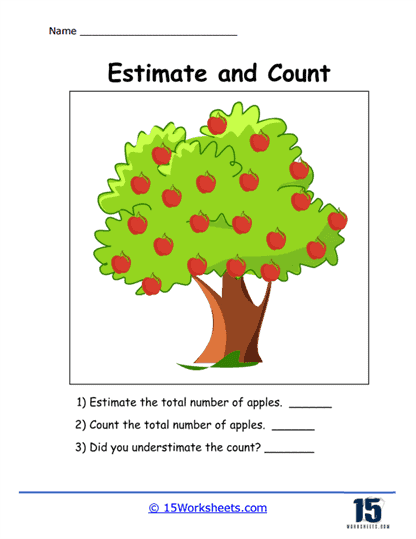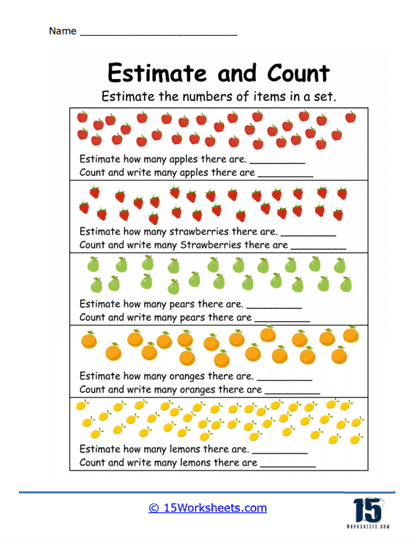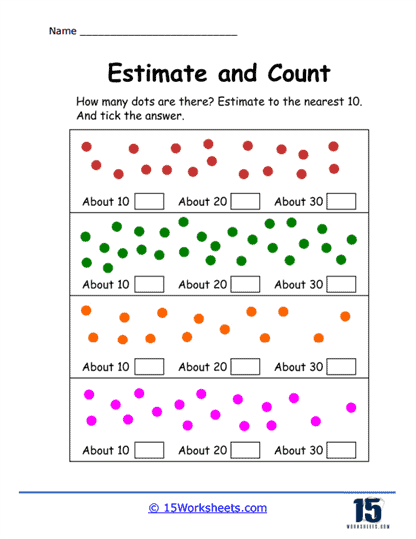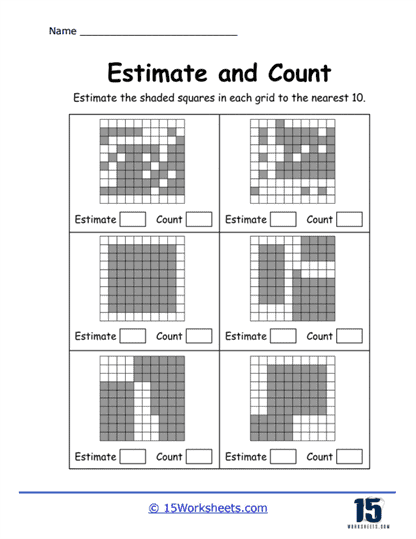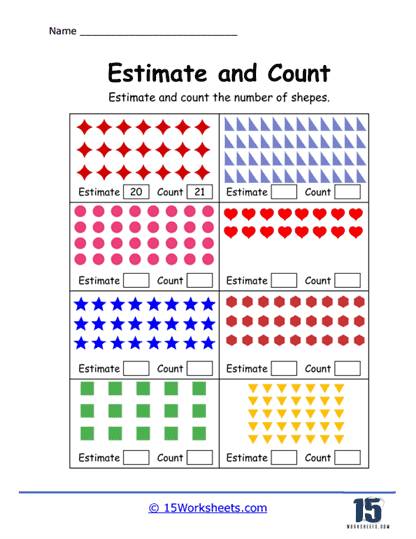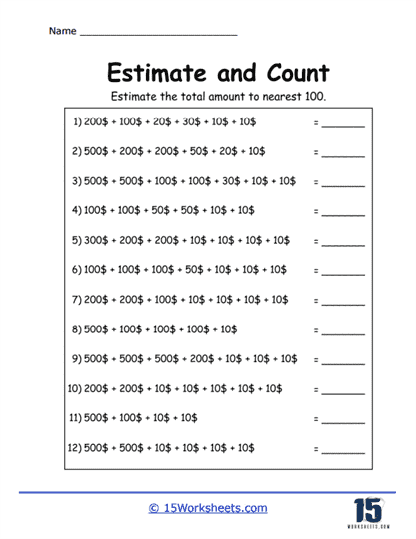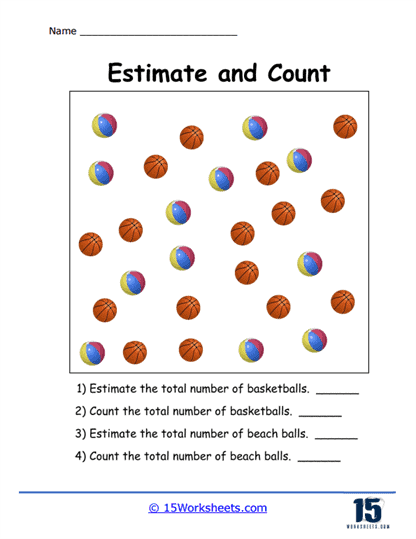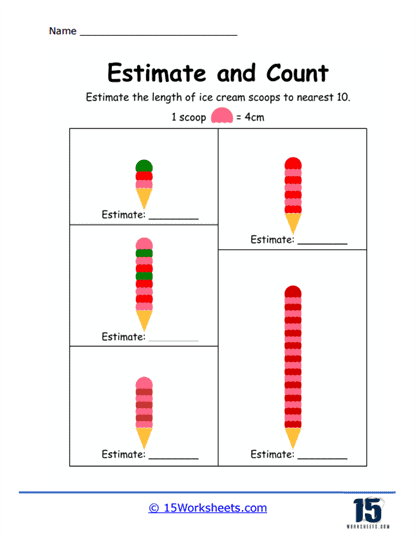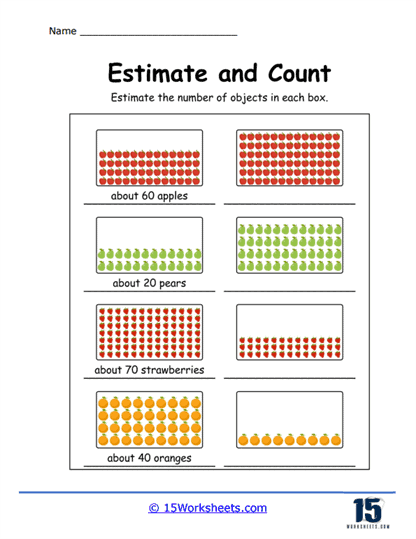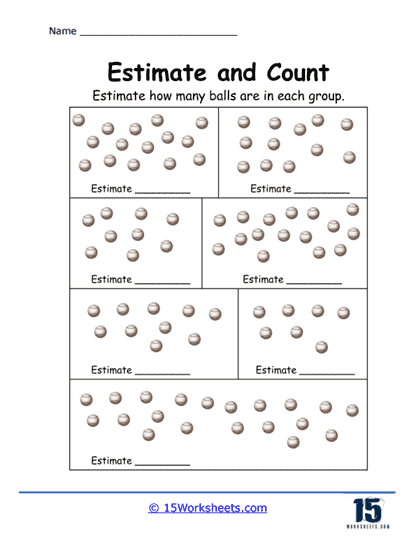Estimate the Count Worksheets
About These 15 Worksheets
These worksheets will help students develop their estimation skills by challenging them to approximate the total number of objects or items in a given set. These worksheets are a staple in elementary and middle school math curricula, but they can be adapted for use at different educational levels depending on the complexity of the tasks involved. The primary objective of these worksheets is to teach students how to make quick, reasonable guesses or estimates when exact counting isn’t feasible, a skill that is not only vital in mathematics but also in everyday life.
When you pick up these worksheets, the first thing you’ll notice is a series of images depicting various objects arranged in different patterns or configurations. These objects can range from simple items like dots, stars, or shapes to more complex or thematic items like apples, candies, animals, or even abstract representations like tally marks. The goal for the student is to look at these images and estimate the total number of objects without actually counting each one. This process helps students practice making informed guesses based on visual grouping, patterns, and spatial understanding.
One of the most common types of tasks you’ll find on an Estimate the Count worksheet is the estimation of grouped objects. For example, students might be shown a picture of several groups of dots or stars arranged in clusters. Each cluster might contain a similar but not identical number of objects. Students are then asked to estimate the total number of objects across all clusters. This type of activity encourages students to recognize patterns and use multiplication or addition strategies mentally. They might, for instance, approximate the number of items in one cluster and then multiply by the number of clusters to reach their estimate. This task not only reinforces their understanding of multiplication and addition but also hones their ability to quickly assess quantities in a visual format.
Another type of exercise you might encounter involves estimating the number of objects scattered randomly across a page. Unlike the grouped objects, these items are not neatly arranged, which makes counting more challenging and estimation more critical. Students must rely on their sense of spacing and density to make a reasonable guess. They might mentally divide the page into sections, estimate the number of objects in one section, and then extrapolate that to the entire page. This kind of task emphasizes spatial reasoning and helps students develop a more intuitive grasp of quantities and distribution.
These worksheets also include exercises that focus on comparing quantities. In these exercises, students are presented with two or more sets of objects and asked to estimate which set has more, or whether the sets are roughly equal. This comparison activity teaches students to make relative judgments about size and quantity, which is an important skill in both mathematics and real-world decision-making. For instance, when comparing two sets of scattered objects, students practice making quick assessments about which set is larger based on visual estimation rather than precise counting. This helps them develop a sense of numerical relationships and proportions.
In addition to simple counting and comparison tasks, some Estimate the Count worksheets incorporate more complex scenarios where students must estimate quantities in real-life contexts. For example, a worksheet might show a picture of a jar filled with marbles and ask students to estimate how many marbles are inside. This type of problem not only involves visual estimation but also requires students to understand concepts like volume, capacity, and packing density. By estimating how many objects can fit in a certain space, students apply their math skills in a practical way, making the exercise more engaging and relevant to everyday experiences.
Another engaging variation you might find is themed estimation activities. These could include scenarios tied to holidays, seasons, or specific subjects like science or history. For example, during Halloween, a worksheet might feature a cauldron filled with candy pieces, asking students to estimate the total count. In a science-themed worksheet, students might estimate the number of stars in a galaxy or the number of leaves on a tree. These themed worksheets make learning more fun and can help students see the relevance of estimation skills in different contexts, sparking their interest and imagination.
Aside from the visual and thematic aspects, Estimate the Count worksheets are also valuable for teaching and reinforcing fundamental math skills. One of the key skills these worksheets develop is number sense—the intuitive understanding of numbers, their magnitude, relationships, and how they are affected by operations. When students engage in estimation, they strengthen their number sense by learning to gauge quantities and make educated guesses based on limited information. This is particularly important for young learners, as a strong number sense lays the foundation for more advanced mathematical reasoning and problem-solving.
These worksheets also play a crucial role in developing students’ ability to estimate sums, differences, products, and quotients. For example, after estimating the number of objects in several groups, students might be asked to add their estimates together. This process helps them practice mental addition and reinforces their understanding of how numbers combine. Similarly, if they estimate how many times a certain object appears in different sets, they might engage in mental multiplication, further developing their arithmetic skills.
These worksheets will also teach students to be comfortable with uncertainty and approximation. In many real-world situations, exact numbers are either unavailable or unnecessary, and the ability to make a reasonable estimate is often more valuable. These worksheets help students learn that it’s okay not to have the exact answer, as long as their estimate is close and based on sound reasoning. This mindset is important not just in math but in life, where quick decision-making often depends on good approximations.
To support students in their estimation practice, teachers might use a variety of strategies alongside these worksheets. One common strategy is to encourage students to first make a quick guess, then refine their estimate by considering the details more closely. For instance, after making an initial guess about the number of objects, students could be guided to think about the size of the groupings, the area they cover, or any patterns they notice. This iterative process of guessing and refining helps students improve their estimation accuracy over time.
Another effective strategy is to use benchmark numbers to help with estimation. For example, if students know that a certain section of the page contains about 10 objects, they can use this as a reference point to estimate larger quantities. This approach helps them break down complex estimation tasks into more manageable parts, making the overall process less daunting and more structured.
Teachers might also encourage students to explain their reasoning behind their estimates. This practice not only reinforces their understanding but also helps them develop communication skills as they articulate their thought process. By discussing how they arrived at their estimates, students can learn from each other and gain new strategies for improving their estimation skills.

